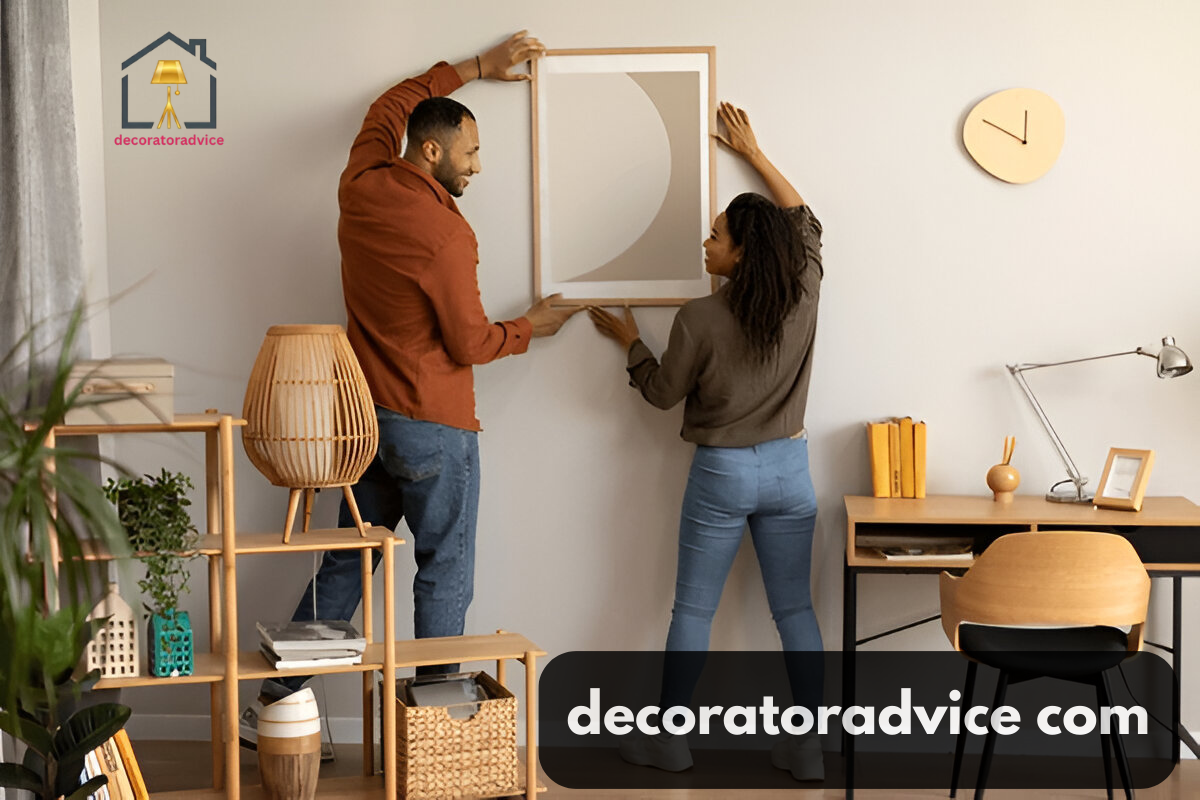You use your living room every day. It should be more than just pretty. It should work well for how you live. DecoratorAdvice com has many ideas to make living rooms smarter. This article brings you fresh, smart living room ideas you can start using now. Some of these are inspired by what’s shared on https//decoratoradvice.com and other home design resources.
You will learn how to arrange furniture so you flow easily through your space. I’ll show lighting tricks that change mood and save energy. You’ll see ways to blend tech without looking messy. You’ll discover color, texture, storage, and style ideas that don’t just look good—they feel good. We’ll compare affordable upgrades to splurge-worthy ones. You’ll also learn what to avoid—common mistakes that waste time or money. About DecoratorAdvice .com, it’s a site where experts and enthusiasts share practical tips for modern homes. Also decoratoradvice .com about gives you a clear look at who we are, what we do, and how we help you make your home look and feel better.
What “Smart Living Room” Really Means
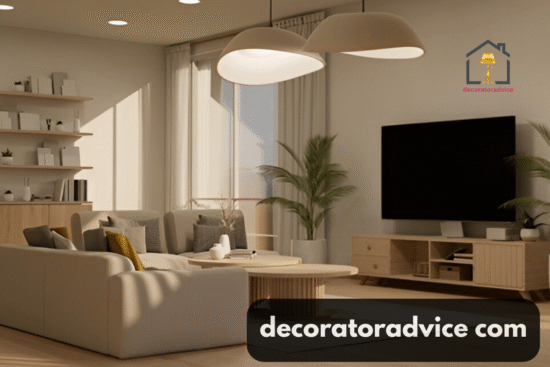
Smart doesn’t just mean gadgets. Smart means form and function in balance. DecoratorAdvice com often points out that a smart living room does more with less. It feels comfortable, looks intentional, and supports how you live rather than getting in your way.
A smart living room is:
- functional but cozy
- tech-enabled but uncluttered
- flexible so you can adapt to different uses
For example, instead of many single-use furniture pieces, choose multipurpose ones. A pull-out coffee table, a storage bench, or seating that creates a defined area. It shows how combining style with utility avoids wasted corners and wasted money.
Tech should serve, not dominate. Hidden charging stations, cordless designs, voice-controlled lights—these feel smart when they disappear when not in use. DecoratorAdvice.com highlights that people care more now about seamless integrations than flashy devices. It’s a principle echoed in decoradtech smart home ideas by decoratoradvice, which focuses on blending technology with living comfort.
Designing Layout & Furniture for Smarter Flow
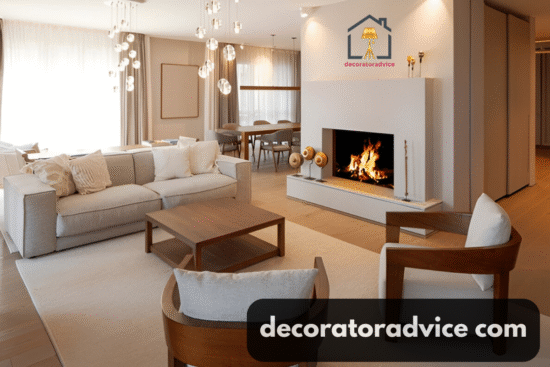
A living room should move with you—you shouldn’t have to dodge obstacles or wish things were closer. This platform often stresses layouts that respect both movement and moments (relaxing, talking, working, and watching TV).
Choose pieces that serve more than one role. A sofa with hidden storage, ottomans that double as side tables, or a console that can function as a desk. DecoratorAdvice com suggests these every chance it gets. For small living rooms, floating furniture off the walls slightly helps. It makes walking paths feel more natural.
Proportion matters. A huge couch in a modest room will feel heavy. Too many small pieces create clutter. Aim for a balance. Measure before buying. Leave breathing room around each major piece so the room feels open. Align key items so focal points (fireplace, window, media) are supported visually and functionally. These simple ideas echo some of the decoration tips decoradhouse from decoratoradvice, which stress balance and thoughtful planning.
Zoning can be helpful. Use rugs, furniture placement, and lighting changes to mark “zones”: lounging, TV, work, and reading. It shows many examples where zone design transforms underused corners into useful spaces. For example: a reading nook near a window, a media wall opposite the sofa, and a corner with plants and a lounge chair.
Lighting, Ambience & Mood
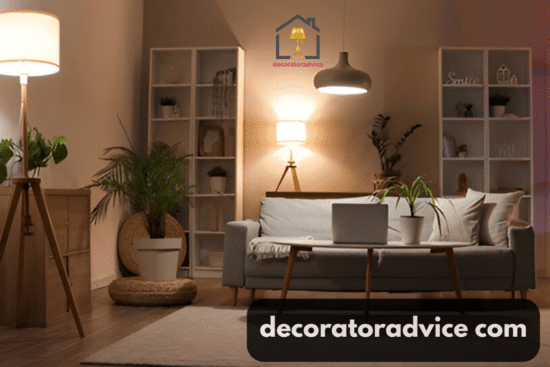
Light changes everything. With the right lighting, a plain room becomes inviting. Decoratoradvice .com home provides many tips on balancing natural, ambient, accent, and task lighting. Use them to create layers of light.
Natural light is your best asset. Let daylight in: sheer curtains, minimal window treatments, and clean windows. In order to direct light into corners, use mirrors opposite from windows. Paint walls in light tones if natural light is limited.
Layered lighting: overhead source (ceiling light or fan), floor lamps, table lamps, and accent spots. Dimmers help you shift mood. When the bright overhead is too harsh, side or floor lamps soften it. Accent lighting highlights a plant, artwork, and bookshelf.
Smart lighting makes it easier. Voice-controlled lights, smart bulbs, and even motion sensors help. You can set routines: lights dim at reading time and are brighter for cleaning. It often shows how tech works best when it fades into the background. For instance, smart bulbs behind a TV wall to reduce eye strain, or warm LED strips under shelves.
Don’t ignore color temperature. Warm tones (2700-3000K) make a room feel cozy. Cooler daylight tones can feel stark unless balanced with warm accents. Use warm bulbs near seating and cool ones near workspaces. DecoratorAdvice’s guides show mood shifts when color temps are aligned with purpose.
Color, Texture & Style Choices That Last
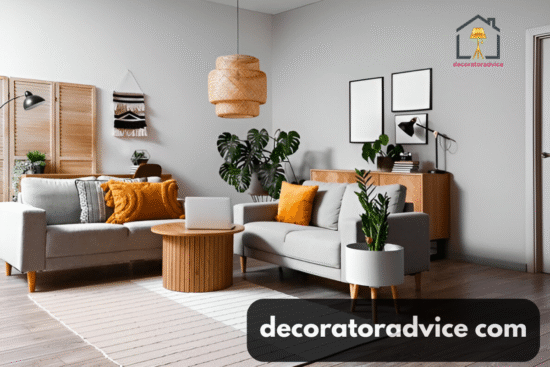
Colors and textures set the tone of your living room. DecoratorAdvice com highlights how palettes, materials, and style coherence lead to spaces people want to stay in.
Start with a base palette. Neutrals—grays, beiges, and whites—offer flexibility. Add accent colors you love. Deep greens, muted blues, and warm rusts are trending. It often uses these as accent tones, not flooding the room. Use pillows, art, and rugs to introduce deeper colors without overwhelming.
Textures matter. Wool rugs, linen throw pillows, matte wood, and rattan. Mixing textures adds depth and interest. It makes a room feel layered. Decorator Advice often draws on nature for texture: live plants, natural fiber baskets, and wood grain.
Style consistency helps. Pick a general direction—modern, transitional, organic modern, coastal, etc. Avoid combining too many styles at once.
One insight less talked about: how emotional memory ties into color and style. People tend to pick colors or items that connect to personal memory. Integrate one or two pieces that matter—a grandparent’s chair, a painting from a trip—to give the room a grounded feel. For practical guidance, you can follow decoradhouse renovation tips from decoratoradvice to update your space effectively.
Smart Tech That Blends, Not Overwhelm
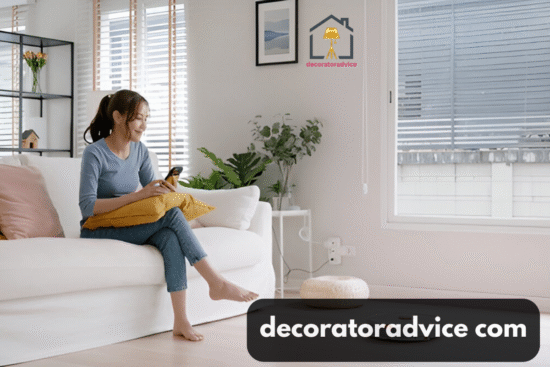
Tech adds value only when it solves a real problem or enhances comfort. Smart integration is key. The best example of this is decoradtech smart home ideas by decoratoradvice which showcases subtle but powerful integrations.f you want to learn more about their design approach and expert team, visit about us decoratoradvice .com.
Start with what you need: lighting, entertainment, climate, and charging. Choose devices that merge with decor. Hidden speakers built into shelves, conduit or cable channels to hide wires, and wireless charging pads built into furniture tops.
Voice control and automation help routines. Set lights to dim at specific times, or have the temperature adjust automatically when you’re away. But avoid buying many devices that don’t connect well. Having mismatched smart devices can be frustrating.
Entertainment tech: wall-mounted TVs, soundbars with slim profiles, and media consoles that hide components.
Energy efficiency: LED bulbs, smart thermostats, and motion sensors for lighting in seldom-used areas. These save money and boost comfort. One case: a homeowner installed smart sensors in a reading nook and hallway so lights only turn on when someone enters. DecoratorAdvice com shows similar small adjustments that add up over time. For the newest trends, paint ideas, and layout inspiration, you can always check the latest decoratoradvice .com updates.
Storage & Decluttering for a Serene Space
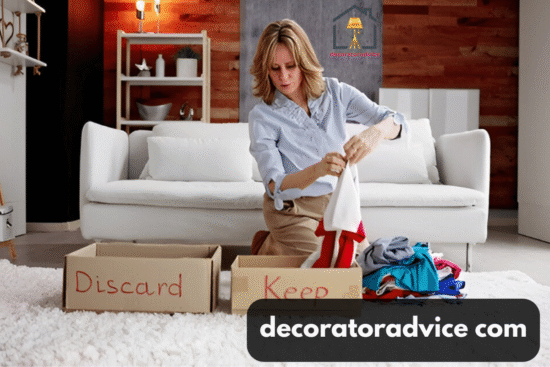
Clutter ruins smart design faster than bad paint. Effective storage turns chaos into calm. Decorator Advice ideas often lean into storage that’s hidden yet accessible.
Cabinets and shelves that are built in make advantage of vertical space. Floating shelves above couches, built-ins around fireplaces. Furniture with storage: ottomans, benches, and side tables with drawers. DecoratorAdvice com shows how bench seating with hidden lids keeps throw blankets and remotes out of sight.
Concealed storage items help. Media consoles that close, baskets that slide under sofas, and closed-front cabinetry. Keep surfaces clear of too many items. Choose a few pieces that matter rather than filling every shelf.
Routine matters. Every week pick up daily items—magazines, chargers, and toys. One unique idea: keep one “display shelf” where you rotate items you like (photos, small art) and store the rest. Decorator Advice often shows rotating décor as a budget-friendly way to refresh without buying new.
Color coordinate storage pieces. Instead than drawing attention to themselves, identical boxes or bins blend in with the space. Use textures to soften their presence—woven baskets, fabric bins.
Tricks to Make Any Room Feel Larger
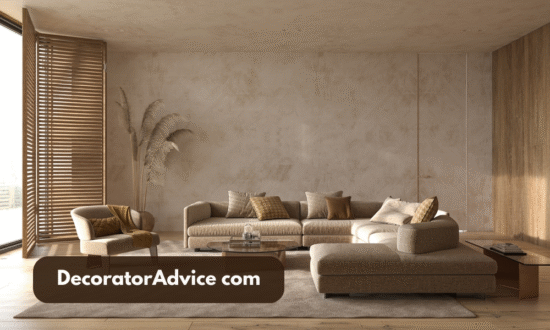
Even large rooms can feel cramped if the layout or lighting is poor. Smaller rooms especially benefit from visual tricks. DecoratorAdvice com shares many ways to give the sense of spaciousness.For the latest news DecoratorAdvice.com shares many ways to give the sense of spaciousness.
Use light colors on walls and ceilings. White or off-white ceilings reflect light. Pale tones or soft neutrals enlarge perception of space. Moldings and trims should be painted identical shade as the wall surfaces to prevent visual gaps.
Mirrors are classic tools. Light is doubled by a single enormous mirror directly from a window. Or use groups of smaller mirrors as art. Reflective surfaces elsewhere—glass tables, gloss finishes—help too.
Furniture scale: pick furniture that suits the room. Don’t force a large sectional into a small room. Instead, pick pieces with slim profiles or legs to let light and sightlines flow. Decorator Advice often shows chairs with open legs, low tables, and items that let you see through.
Let the floor flow. Rugs that match surrounding wood or tile tones reduce visual breaks. Align rug sizes so furniture legs sit on rug edges. Too-small rugs give a room a disorganized air.
Keep windows as unobstructed as possible. Avoid heavy drapery. Consider floor-to-ceiling curtains to make walls look taller. This highlights how drapery height influences perception of space.
Budget Versus Luxury: Where to Spend and Where to Save
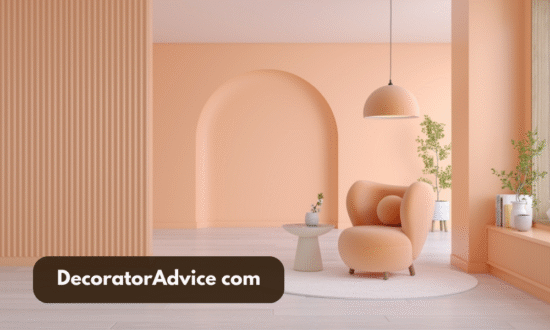
Smart living rooms respect your budget. DecoratorAdvice com often shows how small splurges give big returns. Others are areas where cheaper can work well.
Spend on things you touch often or see all the time: sofa quality, paint, and lighting fixtures. A well-built sofa lasts many years. A quality floor finish or wood accent shows wear better. Lighting hardware often reveals cheapness more than other things.
Save on accessories: throw pillows, smaller décor pieces, and art you love but isn’t priceless. They spoil with trends fastest. You can rotate them.
Consider where investment in technology pays off. A smart thermostat or dimmable lights often saves money long-term. But flashy large-scale tech (hidden projectors, massive systems) may cost too much to keep up with or require constant updates.
One useful perspective: calculate “touched value” (items you touch or perceive every day) versus “seen value” (things you notice when guests come). Prioritize touched value. For example, you sit on the sofa, so invest there; guests notice art, but art can be swapped affordably.
Common Mistakes to Avoid So Your Living Room Actually Works
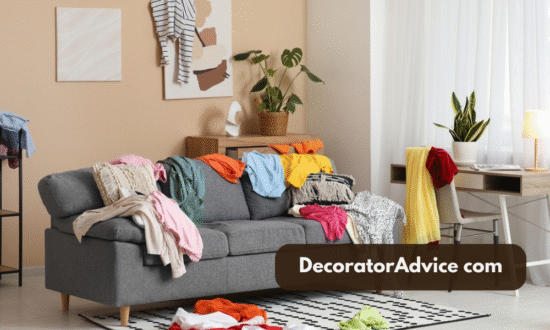
Smart living room design tips are often simple mistakes. DecoratorAdvice often warns against these. Knowing them keeps you from regrets.
Don’t overcrowd. Even if you love many items, too much hurts flow. A crowded sofa, too many chairs, and stacks of decor—these reduce comfort.
Skipping lighting layering leads to flat, uninviting spaces. Overhead lighting only, or one lamp only, makes moments harder: reading, relaxing, and entertaining.
Using purely white or trendy accent colors without considering mood or permanence. A bold paint or wallpaper looks great now but can tire your eyes. Decorator Advice emphasizes choosing colors and finishes that match your long-term taste.
Over-teching can lead to cables, incompatible devices, and outdated gadgets. Always plan for cable management. Choose systems that update well. Put tech in places that make sense for daily life, not just one showpiece.
Ignoring scale: large spaces, mismatched carpets, and furniture that is either too big or too little. Measure. Physically tape out sizes if possible before buying.
The simple guides on https// :decoratoradvice.com make decorating your home easier and more enjoyable.
Final Words: What You Can Try First
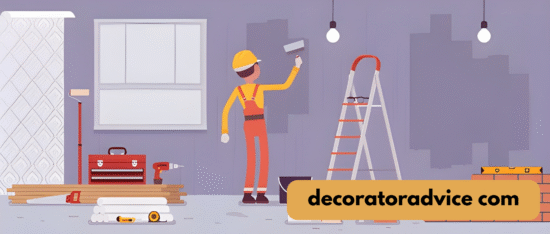
Choose one change that gives a big impact with a low cost. Maybe move the sofa for better flow. Maybe swap overhead lighting for layered lighting. Maybe declutter shelving or conceal wires. A single change by applying ideas from DecoratorAdvice com or tips shared by decoratoradvice .com partners can change how your space feels.
Make a list of what’s most uncomfortable in your current room. Is the lighting harsh? Is storage lacking? Is the room too dark or too busy? Pick that issue. Then apply one smart solution above. Once that works, move to another.
A living room that is smart, beautiful, and comfortable comes piece by piece—not all at once. Use what works for your lifestyle. Over time your space becomes one that feels right for you.

